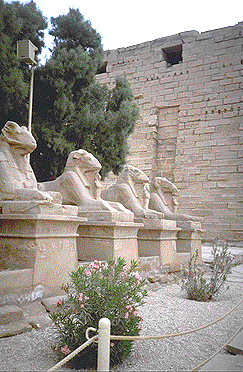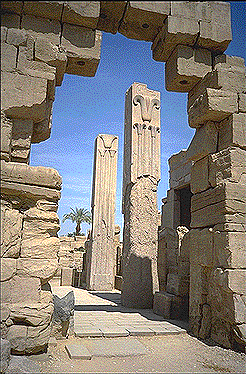Luxor - Karnak Temple

Avenue of Sphinxes and First Pylon of Karnak Temple.
Many of the main roads which lead to the temples of Thebes (modern Luxor) used to be continuously lined with sphinxes. Those which flank the entrance to the First Pylon of Karnak Temple combine the body of a lion with the head of a ram. The ram was a symbol of the god Amun, the chief deity worshipped in the Great Temple of Karnak. Each sphinx protects, between its forelegs, a standing statue of the king--originally Ramesses II (c.1279-1213 B.C.E.).

First Courtyard and Kiosk of King Taharqa at Karnak Temple.
Standing in the shadow of the First Pylon of the Temple of Amun at Karnak (in Luxor, Egypt), one is struck by the length of its east-west axis and the colossal size of its columns. Like all other temples in Egypt, this one symbolizes the mound of the original creation. The ground rises ever so gradually from the entrance toward the sanctuary. The columns are stone replicas of the vegetation which was growing in the the marshy land around the mound of creation.
In the center of this first court are the ruins of the kiosk of Taharqa (690-664 B.C.E.), one column (middle ground, right) of which is complete. Beyond the kiosk in front of the Second Pylon are two standing statues of Ramesses II (c.1279-1213 B.C.E.). Beyond the Second Pylon, the columns of the Great Hypostyle Hall can be seen.

Columns in the Great Hypostyle Hall.
The Great Hypostyle Hall of Karnak was begun during the reign of King Seti I (c.1290-1279 B.C.E.) and was completed by his son, Ramesses II (c.1279-1213 B.C.E.). The north-south axis of the hall provides views which reveal not only the immensity but also the practicality of the architecture. The central row of 12 columns on the east-west axis are 69 feet/21 meters in height, about 33 feet/10 meters in circumference, and have open papyrus capitals. The 122 columns in the side aisles are 43 feet/13 meters in height, 27.5 feet/8.4 meters in circumference, and have closed papyrus-bud capitals (as seen here). Remember that the whole of this hall was roofed with stone slabs, and the interior was quite dark. The difference in height between the central and the side aisle columns was used to provide natural light through clerestory windows which have vertical stone slats (top center).
The huge sandstone columns are carved in sunk relief and were originally painted. The grill of the clerestory window is still visible above the columns.
The Institute of Egyptian Art & Archaeology conducts an epigraphic survey in the Great Hypostyle Hall. [Epigraphy is the recording of inscriptions.] This survey, which was initiated by the late Dr. William J. Murnane, has been funded in part by the National Endowment for the Humanities (a federal agency of the United States). Dr. Peter Brand of The University of Memphis Department of History is the current director of the project.

The Obelisk of Thutmose I at Karnak.
Beyond the Third Pylon and in the Central Court of Karnak Temple is the obelisk of Thutmose I (c.1493-1479 B.C.E.). This is the last of four obelisks which originally stood in front of the Fourth Pylon, which, in the time of Thutmose I, was the entrance to Karnak Temple. The obelisk is 71 feet/21.7 meters in height, sits on a base 6 feet/1.8 meters square, and weighs about 143 tons. Each side of the obelisk has three vertical lines of inscription, the central one being a dedication by Thutmose I.
The obelisk is single shaft of red granite quarried at Aswan.

Pillars of Thutmose III with Emblems of Upper and Lower Egypt.
Just to the east of the Sixth Pylon in Karnak Temple is the vestibule to the sanctuary (right), where the priests kept the portable shrine used for carrying the god's statue in processions. In the vestibule, built by Thutmose III (c.1479-1425 B.C.E.), are these two granite columns, elegant reminders of the importance of the concept of a unified Upper (Nile valley) and Lower (Nile delta) Egypt. These columns are decorated in raised relief with the papyrus on the left (north/the delta) and the Egyptian "lily" on the right (south/the valley).
